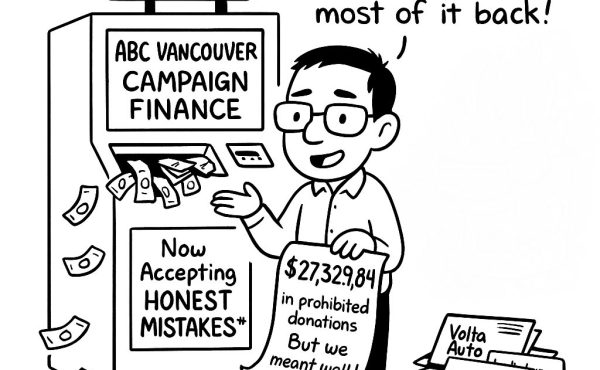

[Editor’s Note: Former Vancouver reporter Christine McLaren is traveling around the world as the resident blogger for the BMW Guggenheim Lab, a mobile think tank investigating solutions to urban problems. In October the project wrapped up its three-month run in New York City — which featured programming by Vancouver author Charles Montgomery — and will travel next to Berlin, and on to Mumbai. This story originally appeared on the Lab’s blog, the Lab|log.]
Few in this day and age would contest the value of any land being set aside for the creation of public green space, and I am certainly not one of them.
But when it comes to the benefits we derive from park space in a city, it is worth considering if bigger is necessarily better.
Earlier this month the State of Illinois, the City of Chicago, and various other agencies made an announcement that caught the eye of many a public space advocate: the construction of the largest urban park in the continental United States.
Dubbed the Millennium Reserve, the project will convert 140,000 acres of underused and postindustrial land on the city’s southern edge into a “recreational frontier” including 53 miles of trails and wildlife corridors, 15,000 acres of open space, the restoration of natural plant and animal habitats, and the conversion of brownfields into parks/garden initiatives, renewable native biomass production, garden nurseries, organic farming, and more.
And it’s not just Chicago that is going big.
New York is currently in the process of converting an abandoned landfill on Staten Island into a 2,200-acre park, which, at nearly three times the size of Central Park, will be the largest park project the city has undertaken in over 100 years.
After the 2012 Olympics, London’s Olympic Park will be converted into the “largest new urban park in Europe for 150 years,” and Mexico City is currently striving to create the largest urban park in the world.
But amid all these large-scale projects it is worth remembering that the sheer size of parks may not always be the best measure of their utility.
Ann Forsyth, professor of city and regional planning at Cornell University and author of Designing Small Parks: A Manual for Addressing Social and Ecological Concerns, calls this the “LA problem,” after the city that has abundant parkland on the hillsides and almost none that is readily accessible in the city itself.
“The useful thing about smaller parks is that they’re actually interwoven into the fabric of the city; they can have a variety of social functions,” she told me in an interview.
“You can’t have pristine nature in a small area, but you can get people to interact with natural processes. Ecologically you get a lot of bang for your buck with a big park, but if you’re going for bang for your buck socially, you’re not going to get it with a big park.”
Forsyth is in no way a critic of large parks. Depending on their design, she says, they can serve many important functions, from acting as natural urban growth boundaries to providing ecological functions.
But especially considering that the people who benefit the most from parks tend to also be those with mobility issues—children, seniors, people with low income—nearly all of the benefits that we as citizens reap from these natural havens have one common element: proximity.
Vancouver author of the upcoming book Happy City, and BMW Guggenheim Lab Team member Charles Montgomery agrees that distribution and access are keys to the success of parkland.
“It goes without saying that we benefit most from parks when we actually spend time in them. So, a megapark can improve quality of life only so much as a) it invites citizens into its embrace, and b) people have regular access to it,” he says.
Aside from the obvious benefits of cleaner air and a, literally, cooler city, the last decade of research has shown that park space increases the value of a city’s property, ups the likelihood its citizens will walk to destinations, calms their nerves, and even decreases their children’s likelihood of obesity.
“We derive powerful benefits from looking at, being in, working in, and playing in nature,” he says. “But if you don’t see it or touch it then the psychological benefit you get from nature is simply in the knowledge that it exists. Knowing that nature exists is good, but it amounts to a small sip from the cup of wellbeing, while interacting with nature is like jumping in an ocean of benefits.”
Montgomery points out that, fittingly, some of the most powerful lessons in the psychological value of access to even the smallest amounts of green space every day have come from Chicago itself.
It was there, for example, that psychologist Frances Kuo learned that simply having a view of nature from one’s apartment made people less aggressive, more helpful, more sociable, more likely to report that they could cope with everyday life, and even less violent.
This is perhaps unsurprising, considering that another study in the United Kingdom found that as little as five minutes of activity in nature per day is enough to boost mood and self confidence.
Kuo’s prescription? “Nature at every doorstep.”
None of this is to say that the Millennium Reserve or similar projects are in vain.
The ecological benefits of the park alone will do wonders for Chicago, a city which actually includes increased tree cover and greenspace in part of their plan to mitigate the looming effects and heat waves that climate change is expected to bring.
Considering that Chicagoans already visit the parks they do have more than the average American city-dweller, it bodes well that many will indeed take advantage of the benefits the park has to offer.
And especially encouraging is the form the park is set to take—a necklace of green spaces intertwined with residential and some commercial uses, albeit concentrated in one section of the city.
But the allure of such a grandiose project should not eclipse the need for integrated green spaces throughout the rest of Chicago, or any city, for that matter—spaces that allow all citizens to experience parks not as destinations, but day to day amenities.
Parks, in a way, are like bike lanes: a single beautiful one is a luxury; a network of good ones is a way of life.
***
This story was originally published on Lab|log at bmwguggenheimlab.org. © 2011 The Solomon R. Guggenheim Museum, New York. Used by permission.
**
Christine McLaren is a freelance journalist who investigates solutions to urban problems. Her writing and research explores how the shape of our cities impacts the lives and behavior of those living in them and how shifting social, environmental, and economic climates are changing our relationship with the urban fabric. She has written and reported for numerous magazines and print, online, and television news outlets, was the lead researcher for award-winning Canadian journalist and Lab Team member Charles Montgomery’s upcoming book Happy City, and conducted research for National Geographic Emerging Explorer Alexandra Cousteau‘s upcoming book, This Blue Planet. She is currently traveling as the resident blogger for the BMW Guggenheim Lab, a mobile urban think tank investigating urban solutions in nine cities around the world.



